Nothing spoils a perfect yard like a plant that decides to take over. These 18 shrubs come armed with bird-dispersed berries, root suckers, and unstoppable growth.
They look great in a pot, but once they escape, they’ll weave through your flowerbeds faster than you can say “garden disaster.” Protect your paradise by steering clear of these leafy invaders.
Butterfly Bush (Buddleja davidii)
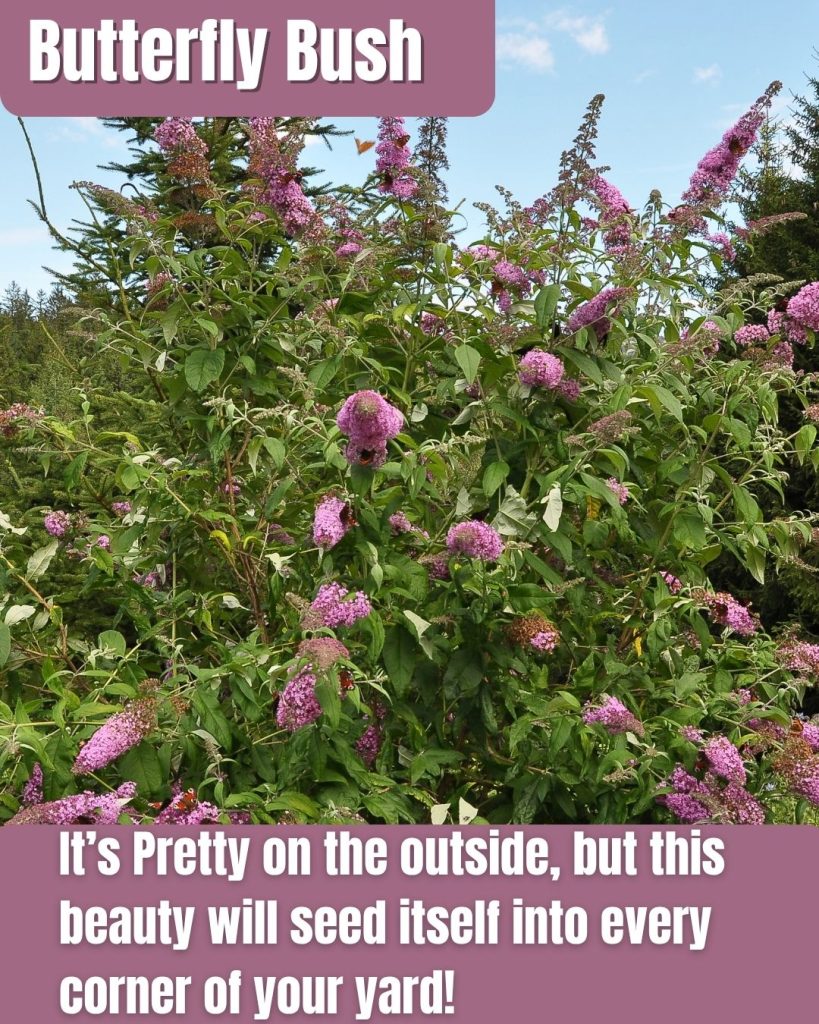
- Birds can disperse up to 30,000 seeds per plant in a single season.
- It blooms from late spring through fall, providing nectar for butterflies and a shortcut to invasion.
- Native to China and Japan, it was introduced as an ornamental in the 1800s and now pops up along roadsides.
The Butterfly bush is loved for its long-lasting, fragrant flower spikes, but those same blooms produce enormous seed clouds that germinate on disturbed soils.
Once established, it forms dense thickets that crowd out native wildflowers and shrub seedlings.
This Asian import’s rapid self-seeding and tolerance for drought make it a garden favorite and a landscape bully.
Glossy Buckthorn (Frangula alnus)
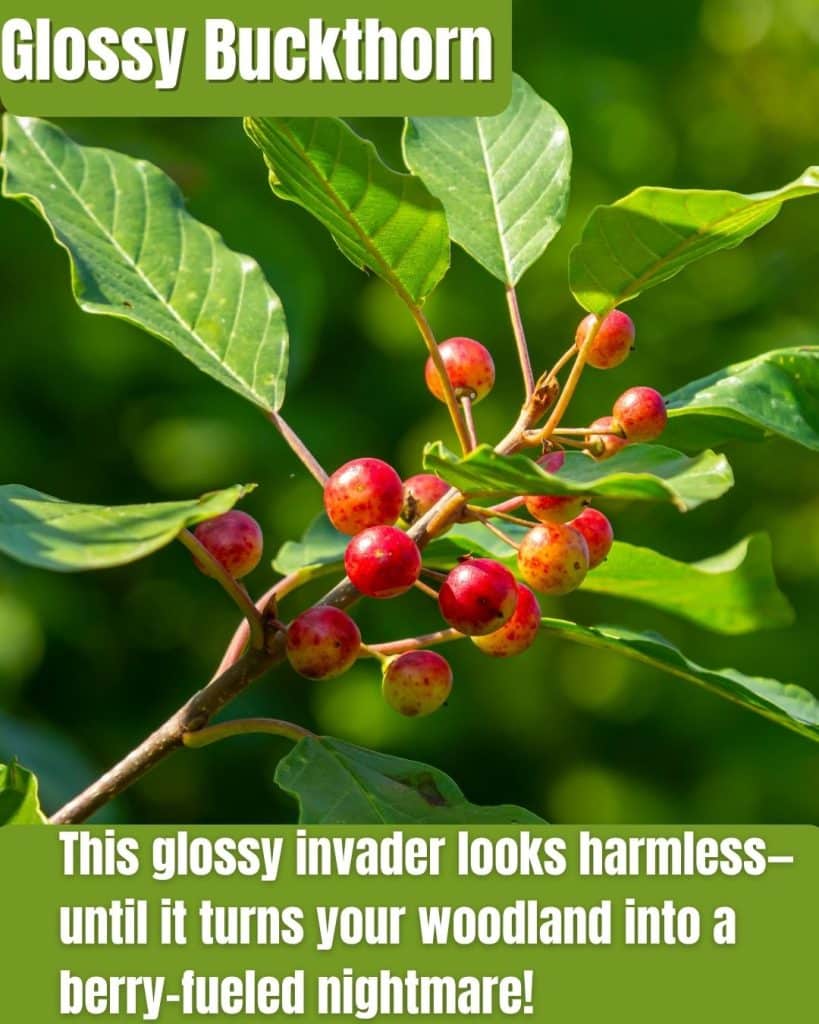
- Each shrub can produce up to 2,000 berries per season, all attractive to birds.
- It tolerates deep shade to full sun, letting it invade forests and open fields alike.
- Spreads both by seed and by sending up root suckers, forming dense clones.
The Glossy buckthorn hails from Europe but escaped cultivation in the 1800s.
Its berries ripen late and feed wildlife through winter, so seeds get widely dispersed.
Once established, its rhizomatous root system sends up new shoots that overwhelm native seedlings.
It thrives in diverse soils, quickly converting diverse habitats into monotonous thickets that resist removal.
Burning Bush (Euonymus alatus)
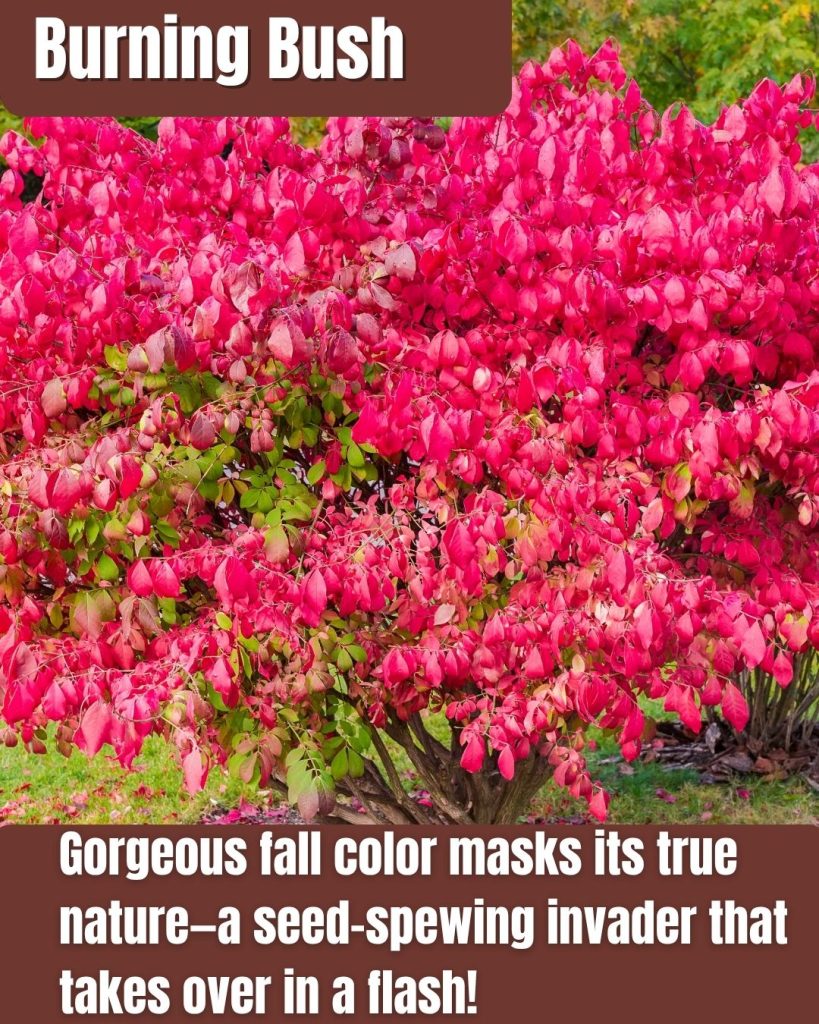
- Each plant can produce up to 10,000 seeds annually, all encased in bright red capsules.
- Its signature corky “wings” along the stems help identify it in winter.
- Native to eastern Asia, it has escaped gardens since the 1860s.
The Burning Bush’s explosive seed set and bird-friendly berries let it naturalize in forests and fields.
Once established, it forms dense stands that shade out native seedlings and alter soil moisture.
Its hardiness across varied soil types and climates makes it a persistent problem for natural areas and home landscapes alike.
Leatherleaf Mahonia (Mahonia bealei)
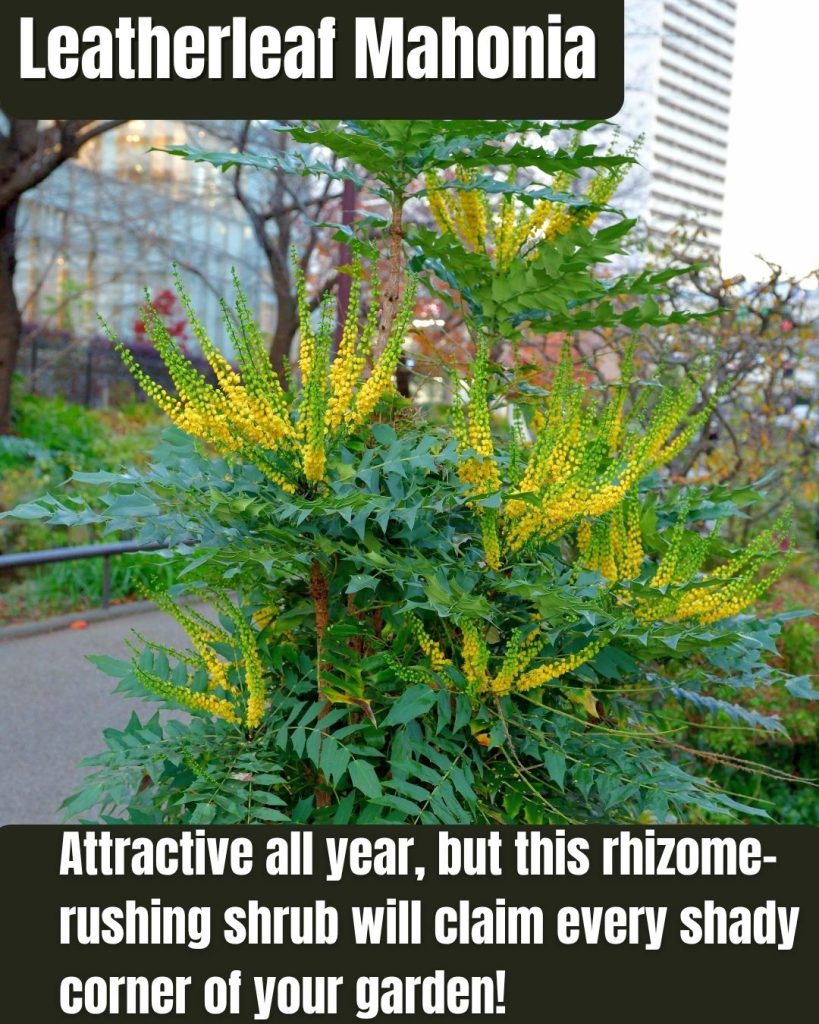
- Spreads via underground rhizomes, quickly sending up new shoots around the parent plant.
- Produces clusters of blue-black berries, which birds disperse into nearby woodland gardens.
- Originally from China, introduced in the early 1900s as an evergreen landscape accent.
Leatherleaf mahonia’s clonal growth habit creates impenetrable thickets that choke out shade-loving natives.
Its winter-blooming yellow flowers and glossy foliage make it popular in shade gardens.
But, its rhizomatous roots allow it to escape beds and colonize forest floors, where removal is a brutal tooth-and-nail battle.
Privet (Ligustrum spp.)
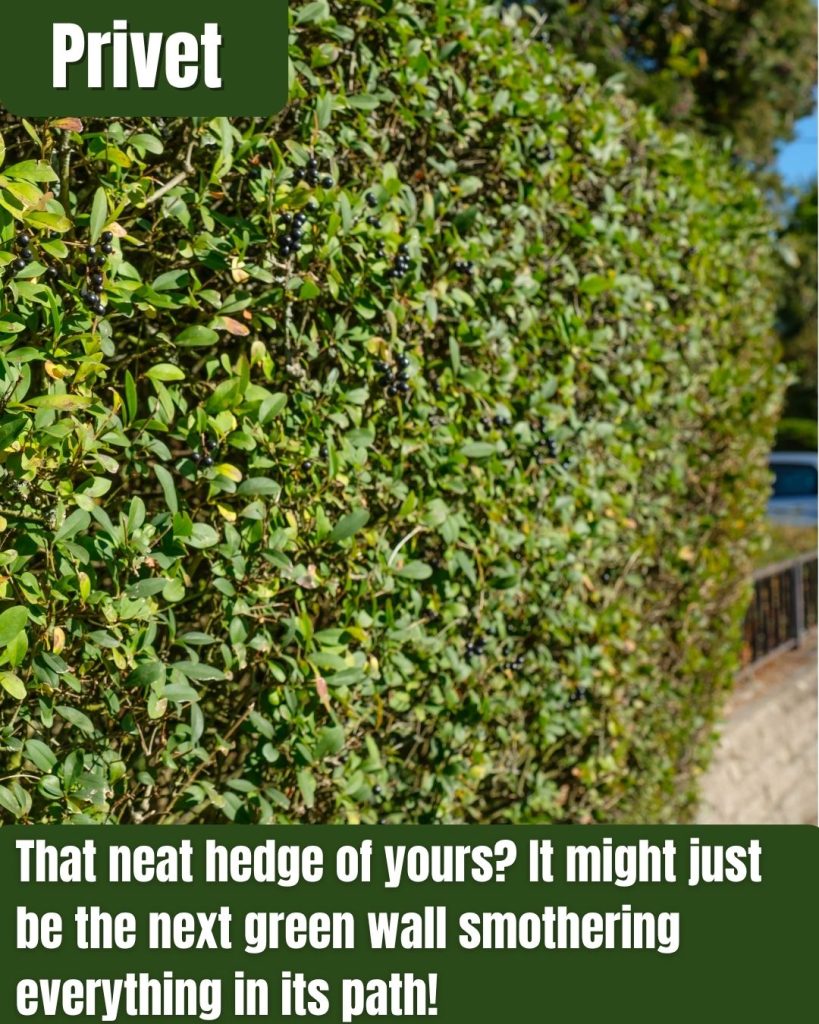
- A single shrub can yield up to 10,000 small berries each year, all eagerly eaten by birds.
- It tolerates deep shade to full sun and resprouts vigorously after cutting.
- Forms dense, evergreen thickets that block light and crowd out understory plants.
Native to Europe and parts of Asia, privet was introduced for formal hedges in the 1700s.
Its bird-dispersed seeds allow it to naturalize along forest edges and streams, while cut stumps send up new shoots if not treated.
Once established, privet’s impenetrable mass can alter habitat structure, reducing diversity.
Manual removal is tough, and chemical control is often required to prevent relentless regrowth.
Amur Honeysuckle (Lonicera maackii)
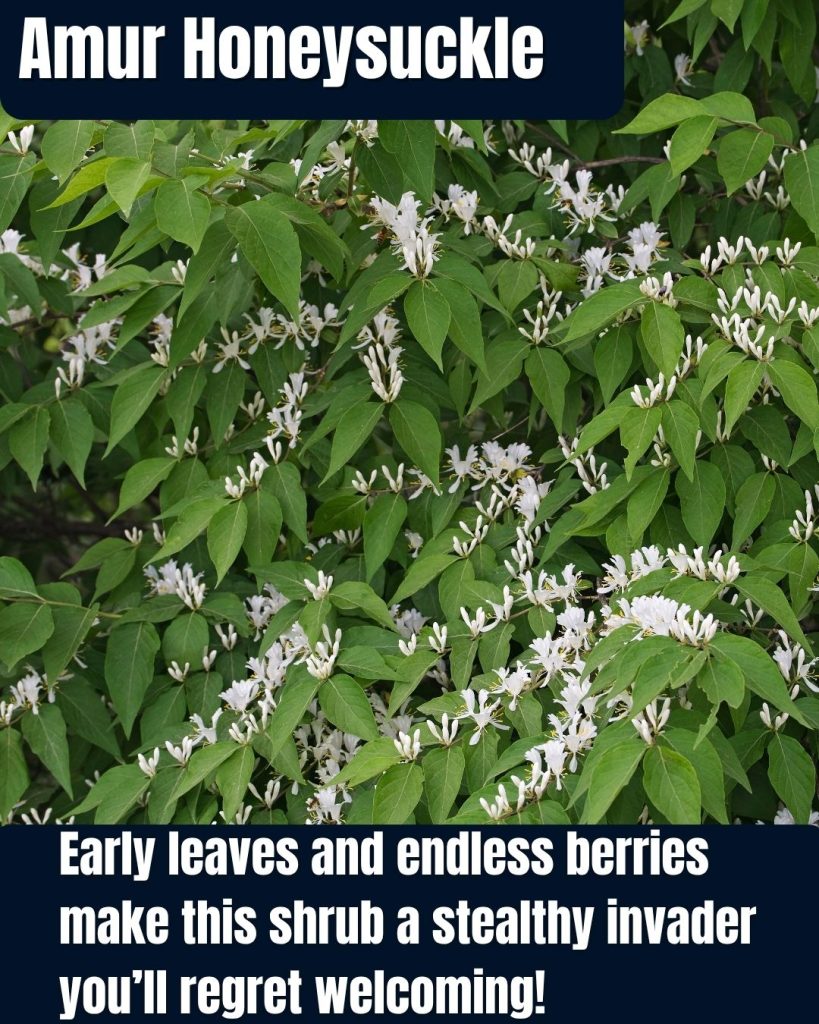
- Leafs out earlier in spring and holds leaves later in fall than most native shrubs.
- Produces bright red berries that birds disperse into woodlands.
- Forms impenetrable thickets up to 12 feet tall via suckering roots.
Originating in northeastern Asia, Amur honeysuckle was planted for wildlife cover and soil stabilization.
Its extended growing season gives it a head start over native plants, while its berries fuel widespread avian dispersal.
The shrub’s dense canopy suppresses spring wildflowers and young trees.
Once it colonizes an area, repeated cutting or herbicide is needed to stop its aggressive suckering and shading habit.
Autumn Olive (Elaeagnus umbellata)
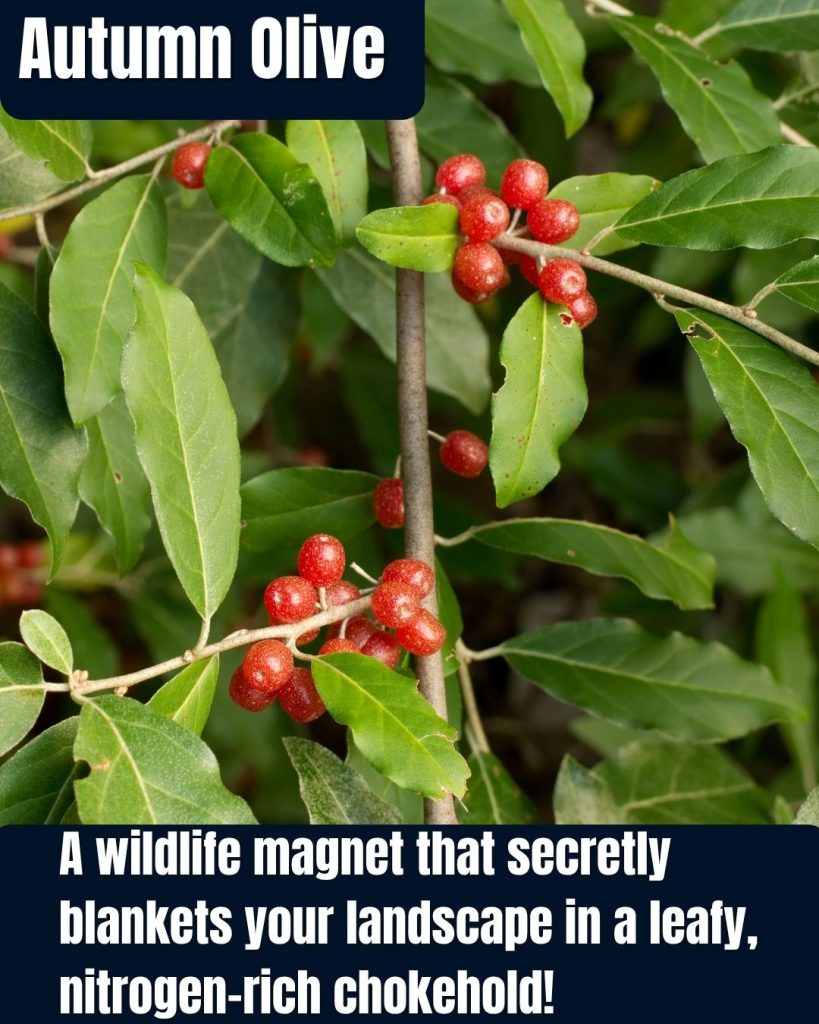
- Fixes atmospheric nitrogen, enriching poor soils and outcompeting natives.
- It can produce up to 100 pounds of fruit per plant each fall, all devoured by birds.
- Sends up suckers from roots to form thickets up to 20 feet wide.
Native to Asia, autumn olive was promoted for wildlife cover and erosion control in the mid-1900s.
Its nitrogen-fixing ability lets it thrive in disturbed or poor soils, while its prolific fruit fosters bird-mediated seed dispersal.
Once in place, root suckers and dense seedlings smother native seedlings, transforming fields and forest edges into near-monocultures that resist both mechanical and chemical removal.
Japanese Barberry (Berberis thunbergii)
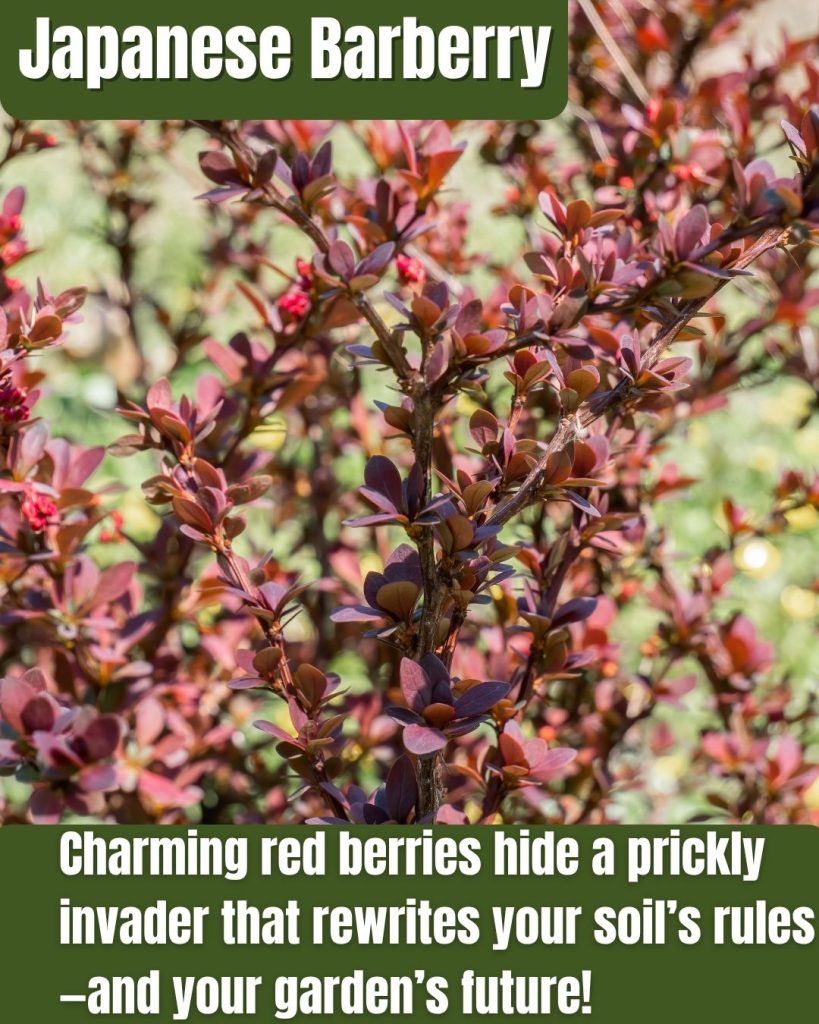
- Each plant can yield up to 10,000 red berries, a favorite snack for birds.
- Forms dense, thorny thickets up to 6 feet tall that block foot traffic.
- Alters soil chemistry, increasing acidity and deterring native wildflowers.
Introduced from Japan in the late 1800s as an ornamental hedge, Japanese barberry’s bird-spread berries and thorny branches enable it to invade woods and fields.
Its dense growth shades out spring ephemerals, while chemical changes to the soil further disadvantage native plants.
Once established, its entangled roots and sharp thorns make manual removal painful and labor-intensive.
Common Buckthorn (Rhamnus cathartic)

- A single shrub can produce up to 4,000 berries, all eagerly eaten by birds.
- It leafs out earlier in spring and drops leaves later in fall, giving it a seasonal advantage.
- Forms dense thickets that suppress spring wildflowers and young tree seedlings.
Native to Europe and Western Asia, common buckthorn was introduced as a hedge plant in the 1800s.
It’s early leaf-out shades native wildflowers before they even bloom, while winter fruits ensure continuous bird-mediated seed dispersal.
Once rooted, it creates monocultures that resist native reestablishment and require non stop vigilance to get rid of.
Nandina (Nandina domestica)
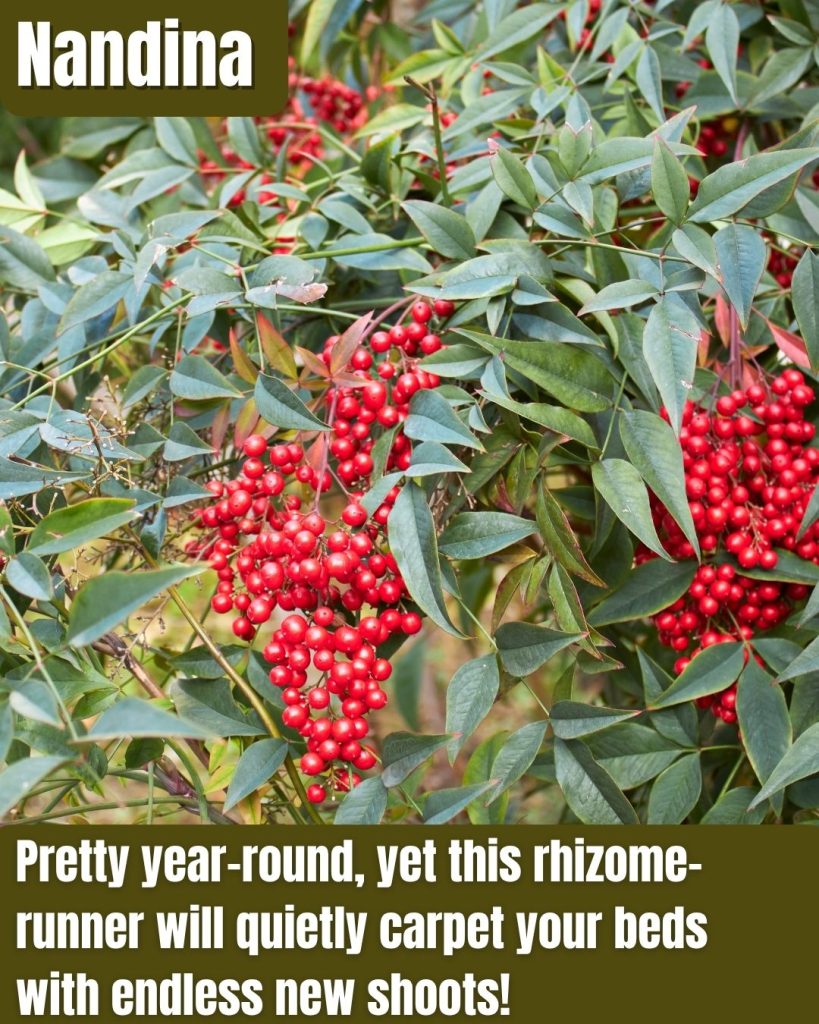
- Spreads via underground rhizomes, rapidly forming large clonal patches.
- Produces bright red berries that persist through winter and attract birds.
- Native to East Asia, it was introduced in the 1800s as an ornamental border plant.
Nandina’s rhizomatous growth enables it to escape garden beds and colonize adjacent beds and wild areas.
Its evergreen foliage and long-lasting berries make it popular in landscapes, but those same berries fuel bird-dispersed invasions.
Established stands are tough to remove, as rhizome fragments left behind will resprout, demanding constant toil or herbicide to fully eliminate.
Sumac (Rhus spp.)
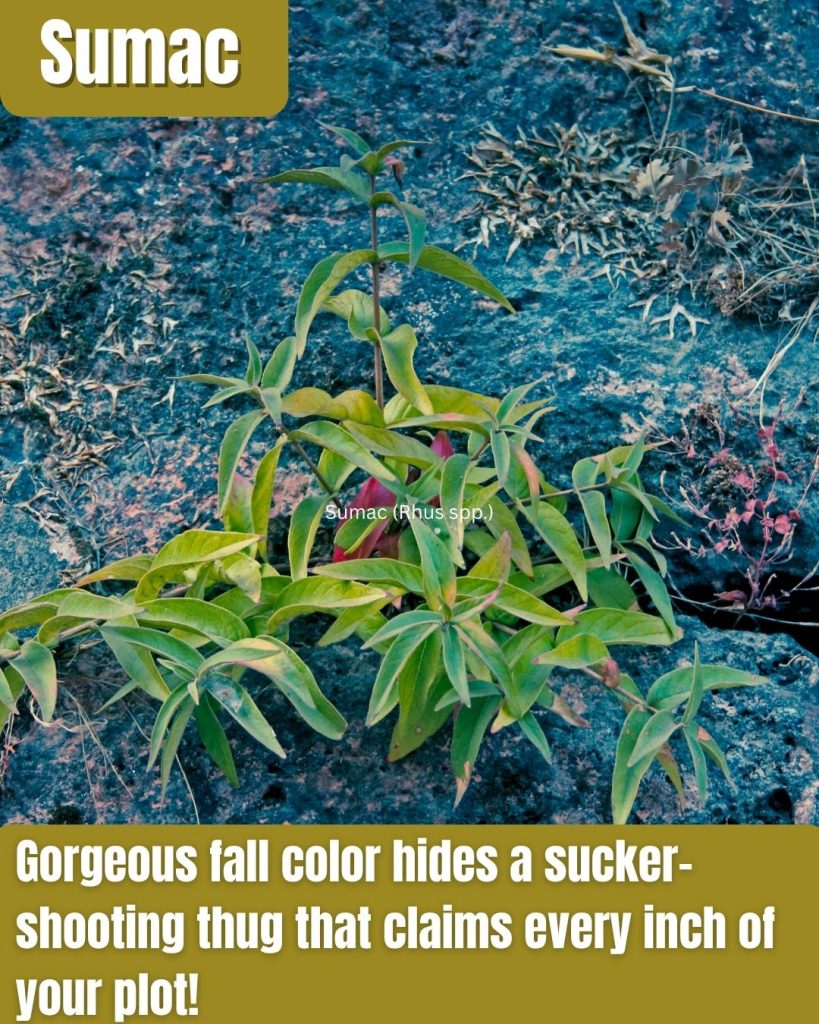
- Sends up hundreds of suckers from its root crown, creating dense clonal thickets.
- Displays vibrant red foliage in fall, making it a popular, but aggressive, ornamental.
- Native to North America, yet even native species can escape garden boundaries via underground runners.
Although many sumac species are native and valued for erosion control, their rhizomatous spread lets them quickly colonize open areas and edge habitats.
Once established, individual plants link into a nearly impenetrable grove that crowds out other perennials and seedlings.
Cutting without digging up the entire root mass almost guarantees resprouts, so sumac removal becomes a long-term battle.
Russian Olive (Elaeagnus angustifolia)
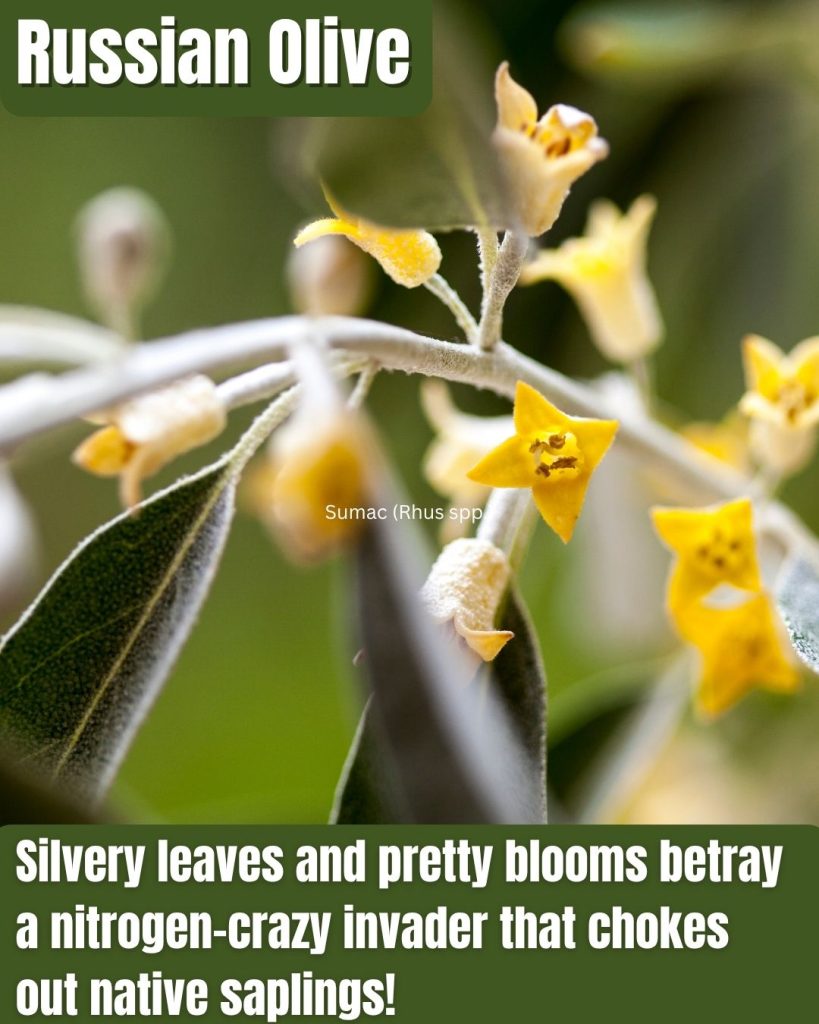
- Fixes atmospheric nitrogen, enabling it to thrive in poor, disturbed soils.
- Produces silvery foliage and fragrant yellow flowers, then copious orange-red fruits that birds spread.
- Originates from Eurasia, introduced in the 1800s for windbreaks and ornament.
Russian olive’s nitrogen-fixing roots and bird-dispersed berries let it invade riparian zones, roadsides, and pastures.
Its root suckers form dense tangles that replace native willow and cottonwood saplings.
Mechanical removal often fails unless followed by targeted herbicide on new shoots.
This hardy invader withstands drought and poor soils, making it a persistent thorn in landscape and wildland management.
Multiflora Rose (Rosa multiflora)
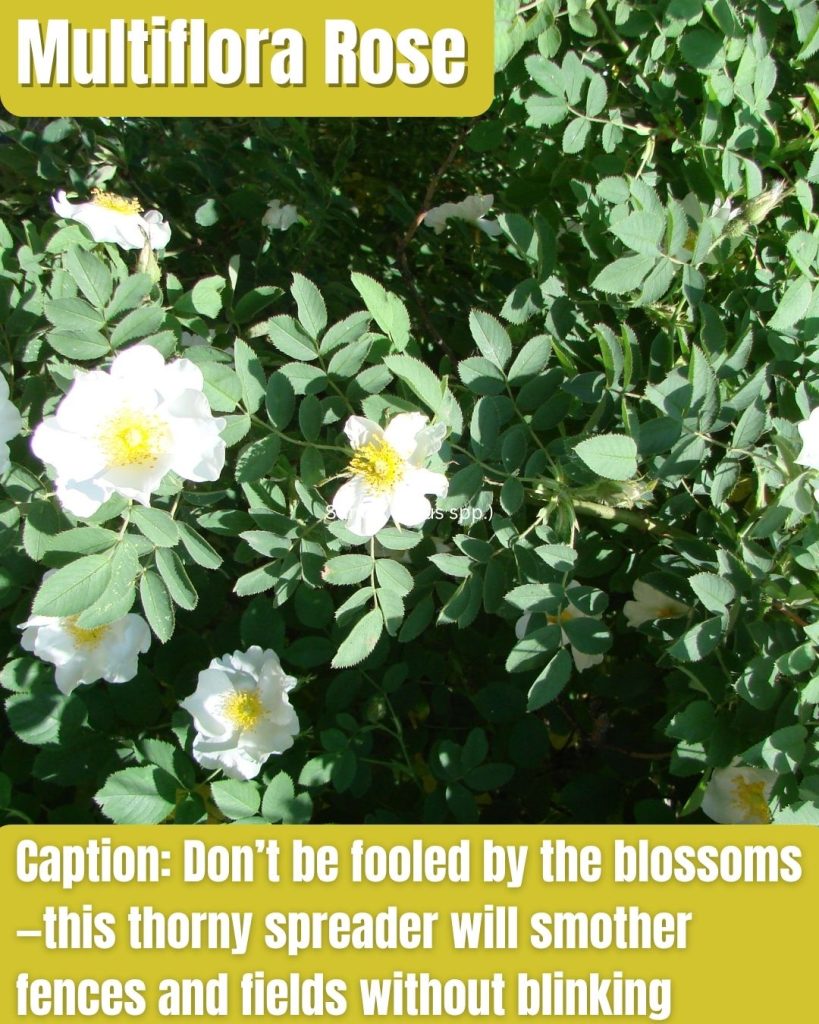
- Each cane can produce over 200 hips (rose berries) per season, all tasty to birds.
- Roots where cane tips touch soil, forming thickets that can span 100+ feet.
- Introduced from East Asia in the 1800s for erosion control and living fences.
Multiflora rose’s aggressive rooting habit and bird-dispersed hips let it escape old hedgerows and naturalize in pastures, fields, and forest edges.
Dense, thorny canes can tangle and overwhelm fences, outcompeting native grasses and wildflowers.
Once established, it resists mowing and cutting. New shoots sprout from any remaining roots, demanding persistent herbicides or root excavation to reclaim invaded areas.
English Laurel (Prunus laurocerasus)
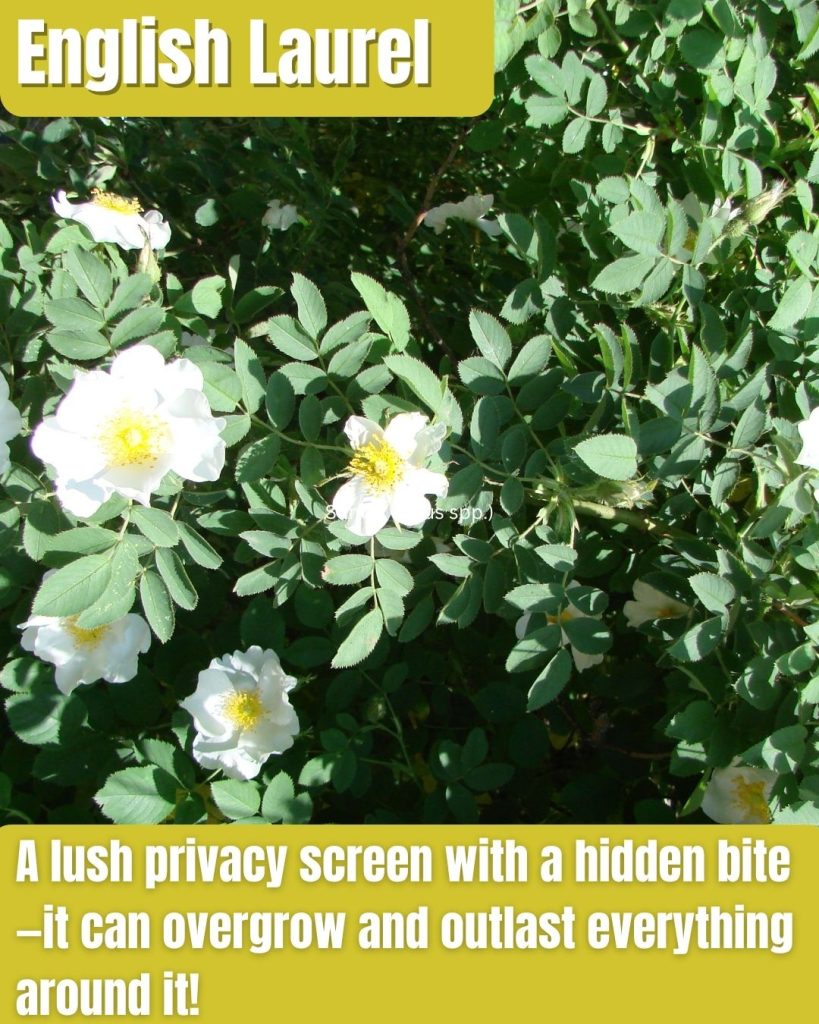
- Can grow 2 feet per year, forming dense, evergreen hedges up to 15 feet tall.
- Produces toxic berries and leaves containing cyanide compounds, deterring wildlife.
- Native to regions around the Black Sea, introduced in the 1800s for privacy screens.
English laurel’s rapid growth rate and shade-tolerant foliage let it form solid barriers that block light to understory plants.
Though its spread into wildlands is less documented, in milder climates it can self-seed under dense canopies and outcompete shade-loving natives.
Its extensive root system can damage foundations and crowd out other garden specimens, making control labor-intensive.
Japanese Spirea (Spiraea japonica)
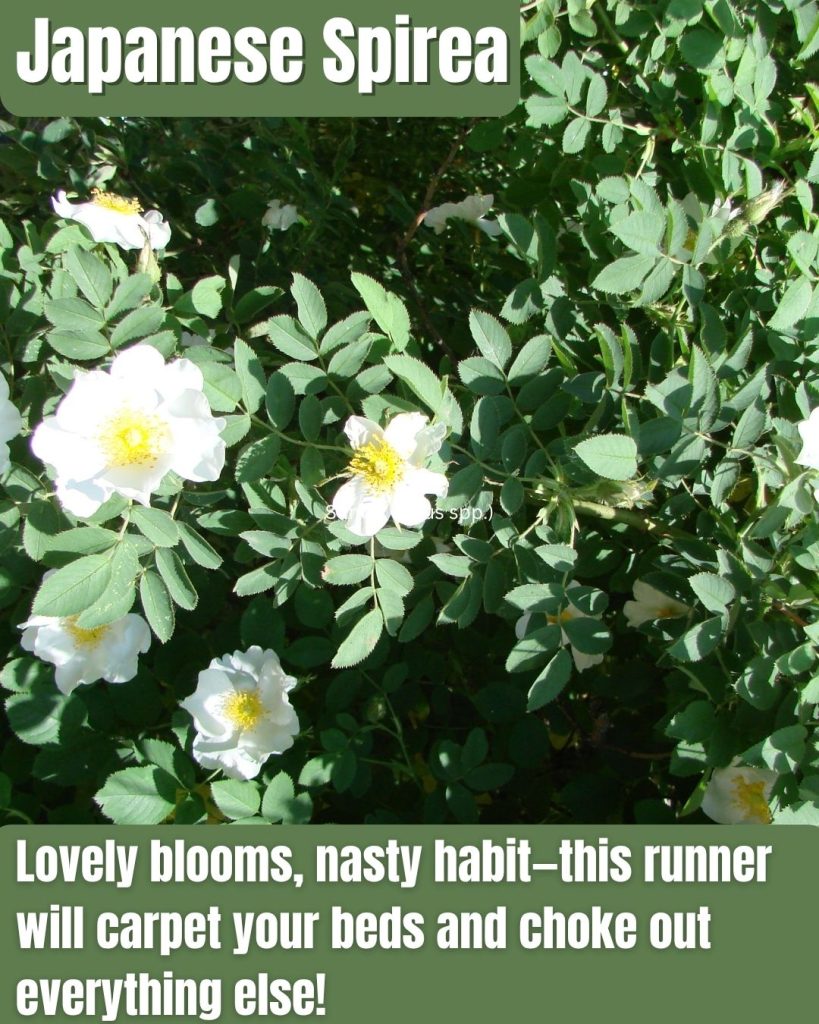
- Spreads via underground runners, creating mats up to 10 feet wide.
- Flowers in early summer, then self-seeds prolifically in garden beds.
- Native to Japan and China, introduced in the 1800s for low-maintenance borders.
Japanese spirea’s rhizomatous spread and self-seeding allow it to escape manicured beds and invade adjacent turf or natural areas.
Its colorful flower clusters mask a weedy habit: stems root at nodes, then pop up new plants when soil is disturbed.
Dense mats crowd out seedlings and reduce biodiversity, requiring repeated tilling or herbicide to eradicate.
Callery Pear (Pyrus calleryana)
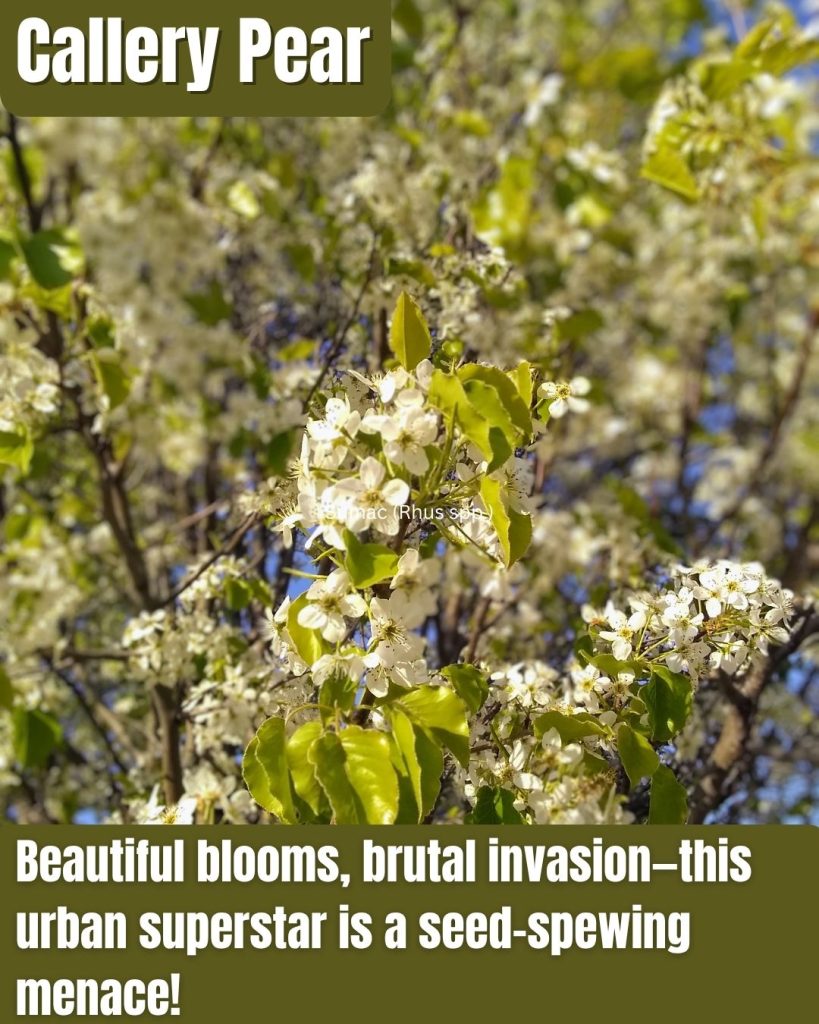
- Commonly sold as “Bradford Pear,” it produces millions of tiny pome fruits that birds disperse far and wide.
- Tolerates urban pollution, compacted soils, and drought, making it a ubiquitous roadside invader.
- Originates from China and Vietnam and readily self-sows beneath parent trees.
Callery pear was touted for its spring flowers and uniform shape but soon proved too adaptable.
It naturalizes in fields and forest edges, forming dense thickets that shade out wildflowers and young trees.
Its propensity to graft multiple cultivars creates even more seed-productive hybrids.
Once established, root suckers and seedlings make control a multi-year battle of pulling, cutting, and herbicide treatment.
Chinese Privet (Ligustrum sinense)
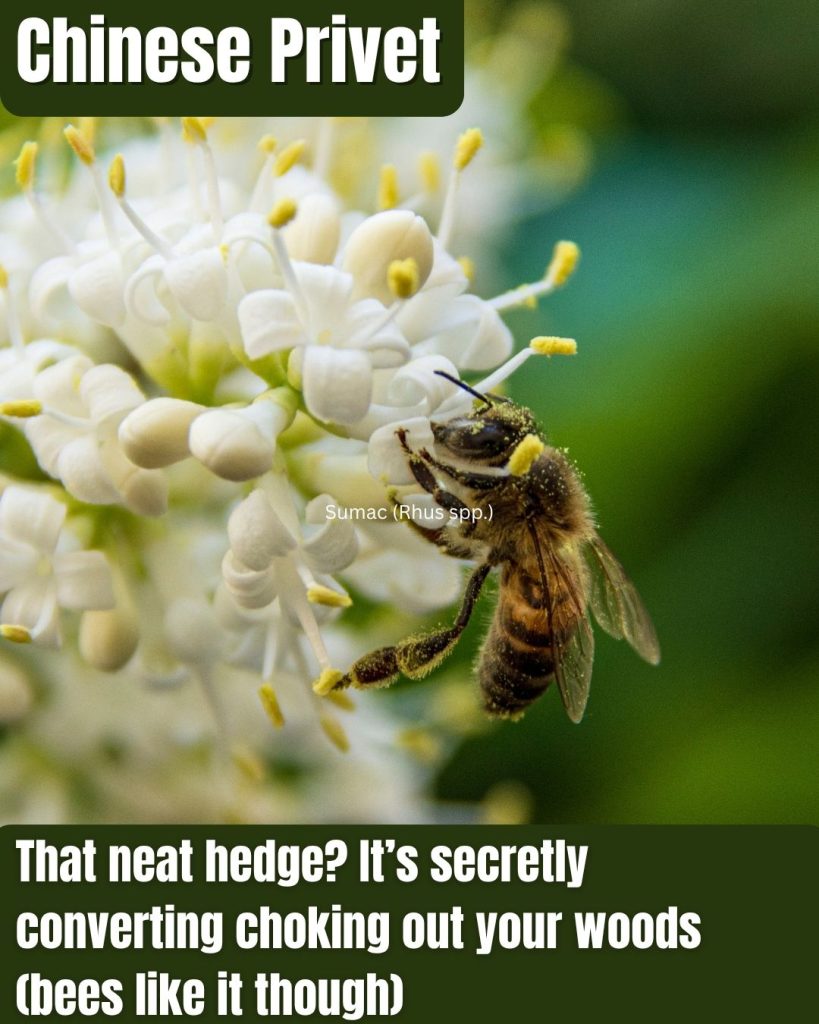
- Produces dark berries in late summer that fuel heavy bird-mediated seed dispersal.
- Forms impenetrable, evergreen hedges up to 20 feet tall and wide.
- Native to China, it was introduced in the 1800s for hedging and windbreaks.
Chinese privet’s shade tolerance and rapid regrowth from stumps let it dominate understories and forest edges.
Once seeds germinate, seedlings and root suckers join forces to create a solid green wall that chokes out native forbs and tree seedlings.
Manual removal requires digging up entire root systems, and without diligent follow-up, even small fragments will sprout new plants.
Tartarian Honeysuckle (Lonicera tatarica)
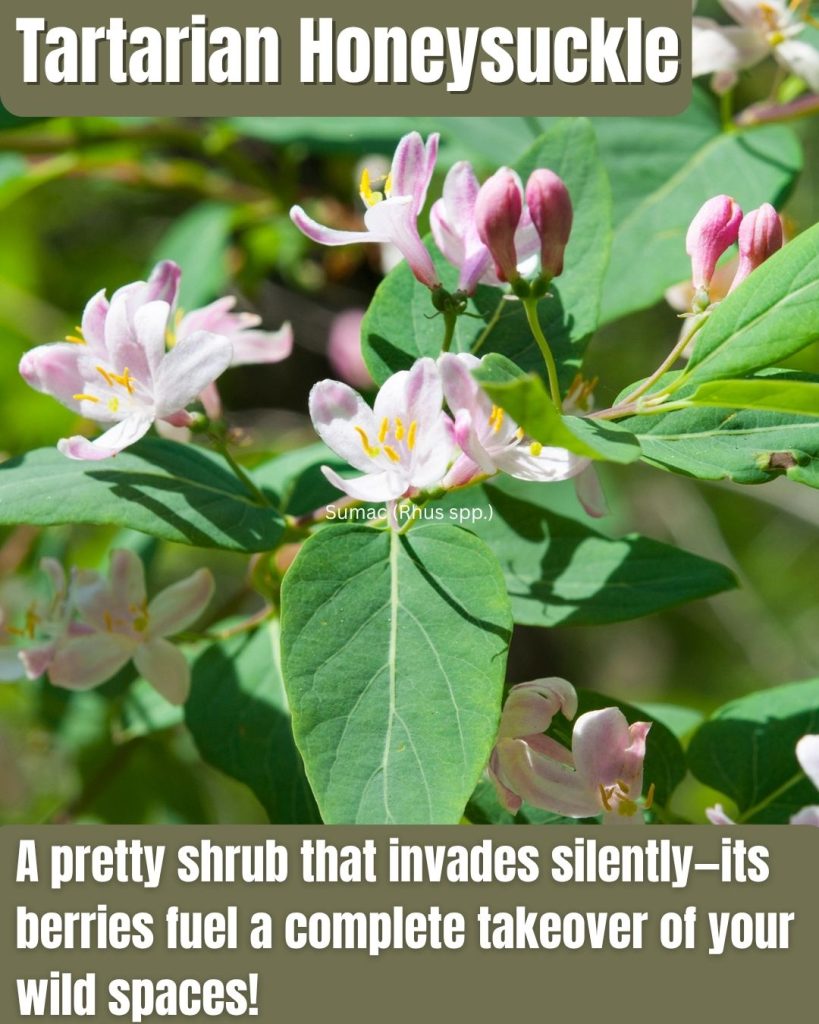
- Each shrub can produce up to 3,000 berries per season, all bird magnets.
- Leafs out early in spring, shading native wildflowers before they bloom.
- Native to Siberia and Manchuria, introduced for ornament and wildlife cover.
Tartarian honeysuckle’s early leaf-out and late berry drop give it a seasonal edge over native shrubs.
Birds feast on its red fruits and spread seeds into woodlands and fields, where it forms dense thickets that block light and hinder forest regeneration.
Control is a NIGHTMARE. Cutting without treating the stump often leads to vigorous resprouting from both stems and roots.
Quick Reference Table
| Image | Shrub | Origin | Where They Grow | Best Control |
|---|---|---|---|---|
 | Butterfly Bush Buddleja davidii | China & Japan | Roadsides, open fields, waste areas | Deadhead spent blooms; pull seedlings; spot-treat with systemic herbicide. |
 | Glossy Buckthorn Frangula alnus | Europe | Forest edges, wetlands, open fields | Cut & stump-treat with herbicide; hand-pull small seedlings. |
 | Burning Bush Euonymus alatus | Eastern Asia | Forest understories, old fields, hedgerows | Cut to ground & paint stumps with glyphosate; remove seedlings. |
 | Leatherleaf Mahonia Mahonia bealei | China | Shade gardens, woodland edges | Dig out rhizomes; follow up with glyphosate on resprouts. |
 | Privet Ligustrum spp. | Europe & Asia | Formal hedges, forest edges, streambanks | Cut & stump-treat; destroy seedlings. |
 | Amur Honeysuckle Lonicera maackii | Northeastern Asia | Woodlands, fields, roadsides | Cut & herbicide fresh cuts; prescribed burning in large patches. |
 | Autumn Olive Elaeagnus umbellata | Asia | Disturbed sites, roadsides, fields | Cut & stump-treat; goats browse young shoots; pull seedlings. |
 | Japanese Barberry Berberis thunbergii | Japan | Woodlands, fields, hedgerows | Hand-pull small plants; cut & herbicide larger shrubs. |
 | Common Buckthorn Rhamnus cathartica | Europe & W. Asia | Woodlands, wetlands, uplands | Cut & stump-treat; pull seedlings; mow in pastures. |
 | Nandina Nandina domestica | East Asia | Landscapes, forest edges | Excavate rhizomes; spot-spray emerging shoots. |
 | Sumac Rhus spp. | North America | Fields, roadsides, edges | Dig out whole root crowns; herbicide resprouts. |
 | Russian Olive Elaeagnus angustifolia | Eurasia | Riparian zones, pastures, roadsides | Cut & stump-treat; remove suckering roots; repeat. |
 | Multiflora Rose Rosa multiflora | East Asia | Pastures, hedgerows, forest edges | Mow/cut repeatedly; stump-treat; excavate roots. |
 | English Laurel Prunus laurocerasus | Black Sea region of Europe | Hedges, gardens, shade | Cut back & dig up root mass; stump-treat roots. |
 | Japanese Spirea Spiraea japonica | Japan & China | Garden borders, roadsides | Pull/till runners; herbicide dense mats. |
 | Callery Pear Pyrus calleryana | China & Vietnam | Roadsides, vacant lots, fields | Pull seedlings; cut & stump-treat; dig saplings. |
 | Chinese Privet Ligustrum sinense | China | Forest understories, hedges | Cut & stump-treat; dig out small plants; foliar spray. |
 | Tartarian Honeysuckle Lonicera tatarica | Siberia & Manchuria | Forest edges, old fields, roadsides | Cut & paint stumps; prescribed burning; pull seedlings. |